
How much should a small business marketing team spend on marketing? Convention demands that B2B companies allocate 2% to 5% of their revenue to marketing. In reality, it exceeds 10%, and the percentage for B2C businesses is significantly greater.
With such stringent pricing, many small business marketing teams find themselves short on staff and cash as they attempt to implement marketing strategies. While many small business marketers believe they must pick between marketing well and marketing cheaply, this is not the case.
There are numerous resources available to assist small business marketers in successfully advertising to their target customers within the constraints of their current budget. The following are three advertising suggestions to assist small business marketers in effectively and economically promoting their products and services across digital, social, audio, and video channels.
The SaaS business continually makes new, improved, and perpetually reasonable ways of advertising across all mediums. YouTube and TikTok, for example, are popular social and video platforms that are both free and inexpensive.
Once a business has owned content on a business site (more on that in Tip 3), it can launch targeted campaigns using Google Ads, Facebook Ads, and other pay-per-click (PPC) digital advertising channels. These are some of the more common options, but there are other really effective, low-cost alternatives available.
Consider the opportunity provided by audio streaming services; millions of people are basically captive audiences on their daily commute. Advertising on these channels has become more accessible because of specialty solutions such as AudioGo. Through a suite of audio ad creation templates and tools, this platform takes the idea of audio advertising to the next level. It can push advertisements out to top streaming music, radio, and podcast networks. Users can easily create and schedule ads, target them to the right audience, and launch campaigns with budgets as low as $250 thanks to the user-friendly interface.
While AudioGo succeeds at arriving at a wide variety of audiences through audio advertising, brands that have their own podcasts could profit from podcast distribution networks like Audioboom. This platform makes it easier for advertisers and podcasters with similar interests to reach their niche audience. You can host a podcast for less than $10 per month, and monetizing your content could even help you make more money.
When a small marketing team has restricted money owing to its size, it can nevertheless maximize how those funds are invested by looking for solutions that allow them to contact potential or existing customers at a low cost. Businesses may maximize their advertising budget by utilizing both user-friendly development tools and targeted advertising possibilities.
Advertising does not always have to pit a small business against the world. Partnerships and collaborations can be formed with companies in comparable positions. The trick is to distinguish between competitors and partners.
For example, a bouncy house delivery firm may see a party rental company as a competition. However, the two brands are not at odds if the latter specializes in tent, table, and chair delivery. They simply serve the same customer base.
It is essential to distinguish between two businesses, even if they operate in the same industry. A telemarketing company may regard another call center as a competitor. However, one may work with phone training in general, while the other with a specific target market.
When marketers uncover both local and remote companies with which to cooperate, they can generate new advertising opportunities. Pooling resources allow them to swap advertising space with their audiences and magnify their marketing efforts. They can also design bundles and packages that provide discounts when purchased together. The best part is that all of this is available for little or no cost.
Finally, small-business marketers should never underestimate the importance of owned content. The word owned media (particularly when developing audio and visual commercials, such as those outlined in Tip 1) refers to content that a marketer has complete control over.
A blog post or how-to video on a company’s website is considered owned media. Social posts and pay-per-click advertising are not owned media. Marketers should maximize the promotional media under their company’s control.
Every piece of content that a small business marketing team produces has the power to influence its consumer base. It may educate buyers, address customer pain points, and position the company as an industry authority. High-value content can also help a brand rank better in search engine results pages, which can boost organic traffic to its website and sales funnels.
What is the best part? Owned content may take some effort to create, but it belongs to the creator forever. There are no fees. There is no pay-per-click. When done correctly, quality content is a long-term advertising strategy that may serve a company for months or even years with little maintenance.
DafaNews, a prominent platform providing real-time sports updates and in-depth analysis, has launched “The Game… Read More
Travel has a way of enriching the soul, offering experiences that shape perspectives and create… Read More
The commercial real estate industry is changing rapidly, driven by technological advancements, sustainability initiatives, and… Read More
Zoom Tasks, a new AI-powered task management tool integrated into Zoom Workplace, has been formally… Read More
Akola, Maharashtra – A trailblazer in psychiatry and holistic healing, Dr. Deepak Kelkar has spent… Read More
Philanthropic work plays a key role in addressing the most important challenges faced by societies… Read More